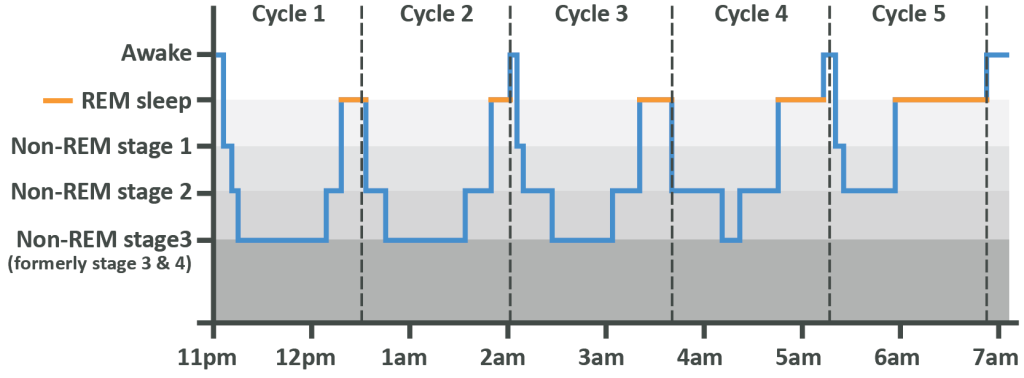Sleep cyclees
As you read above, sleep is not a homogenous experience, but rather a multi-stage process which occurs through the night. You may be thinking, that you progress from stage 1, to 2, to 3 and to REM before waking up but this is not the case. Rather, you cycle through all 4 in the first 70-100 minutes of sleep, then the following cycles repeat in loops lasting around 90-120 minutes.
As each cycle occurs, REM sleep increases while stage 3 decreases meaning that the first half of the night is the sleep which helps to rejuvenate your mental abilities and feelings of being refreshed, while the latter half seems more important for learning and developing new skills. We will return to how sleep impacts this later.
The structure of these various sleep cycles is described under the term ‘sleep architecture’, and it changes across your lifetime in profound ways. Here we will speak only in terms of adult sleeping patterns, to avoid going into more detail than is practical.
Perhaps the most efficient way to present information about sleep patterns is via a hypnogram, which is a readout created by combining information from 3 pieces of equipment – namely the eletrooculograph which measures eye movement, the electroencephalogram (EEG) you encountered earlier and an electromyograph which detects muscle innervation as a surrogate for movement.
Below is a sample hypnogram – notice the relative length of REM and Stage 3 sleep as the night progresses.

Note: Sleep doesn’t function in a stepwise 1, 2, 3, REM pattern but rather 1, 2, 3, 2, REM for the first cycle, followed by cycles which either cycle as 2, 3, 2, REM (missing the falling asleep stage) or 1, 2, 3, 2, REM. Stage 2 is repeated twice per cycle, which is why it makes up so much of your total sleep.
As you can see on the above graph, due to the length of time an average adult sleeps and the duration of each cycle, most individuals will experience 5-6 sleep cycles per night if they have rested well. Waking for a short time during the night (as per the above during REM sleep) is not really a problem as waking during REM sleep allows you to slide straight into your next cycle, but if you are awake for a long period you risk missing a cycle and losing out on stage 3 and REM sleep.
So now you understand how you sleep at a basic level, let’s briefly run through the key points:
- Sleep is a multi-stage process involving cycles between REM and non-REM sleep
- Non-REM sleep can be further subdivided into 3 stages (or historically 4) which are numbered in ascending order in line with ‘deepness’ of sleep
- Each stage can be tracked and defined judging by the frequency and amplitude of waves measured by an EEG during sleep, though due to the continual nature of these waves the categorisation is inherently somewhat arbitrary
- Each stage has a specific purpose. Stage 1 is the falling asleep stage which prepares you for sleep, stage 2 seems to be important for memory consolidation and sleep protection and stage 3 seems important for rejuvenation
- REM sleep seems important for complex learning but also infant development
- Each cycle lasts around 90 minutes
- Sleep is not a state of rest which occurs because your brain shuts down, but is rather an important state caused by the brain, and during which the brain is still active
- Waking briefly during REM sleep is not an issue but overly stimulated individuals may wake during this time and stay awake, leading to lost sleep
- Waking during stage 1-3 sleep leads to progressively worst sleep inertia
As we hope this section has shown you, sleep is a highly dynamic and complex process which potentially plays a number of roles – but why do we do it?